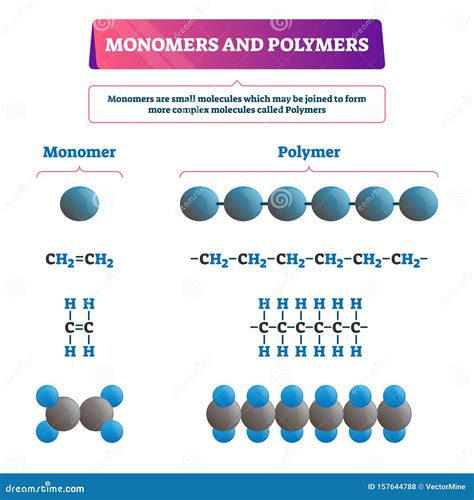Monomers: The Building Blocks of Polymers
Monomers are the basic units that make up polymers, which are large molecules found in a wide range of materials, from plastics to proteins. Understanding monomers is essential for comprehending the properties and applications of polymers.
What is a Monomer?
A monomer is a molecule that can be linked to other molecules of the same or different type to form a polymer. Monomers are typically small molecules, often containing just a few atoms. They can be organic or inorganic, and their structure can vary greatly.
Polymerization
Polymerization is the process by which monomers are linked together to form polymers. There are two main types of polymerization:

1. Addition Polymerization:
In addition polymerization, monomers with double or triple bonds react with each other to form a polymer with a backbone of saturated carbon atoms. The monomers add onto each other in a chain-like fashion, forming long, linear polymers.
2. Condensation Polymerization:


In condensation polymerization, monomers with functional groups (e.g., alcohols, acids, amines) react with each other, forming a polymer with a backbone of repeating units linked by -O-, -N-, or other functional groups. Monomers lose small molecules (e.g., water, ammonia) during this process.
Types of Monomers
There are many different types of monomers, each with its own unique structure and properties. Some common types include:
-
Ethylene: A simple alkene monomer that forms polyethylene, a common plastic used in packaging and construction.
-
Styrene: An aromatic monomer that forms polystyrene, a lightweight plastic used in disposable cups and insulation.
-
Methyl methacrylate: A methacrylate monomer that forms polymethyl methacrylate (PMMA), a transparent plastic used in acrylic sheets and lenses.
-
Vinyl chloride: A vinyl halide monomer that forms polyvinyl chloride (PVC), a tough plastic used in pipes, flooring, and window frames.
-
Glycine: An amino acid monomer that forms proteins, the building blocks of life.
Applications of Polymers
Polymers are used in a vast array of applications due to their diverse properties, which can be tailored by combining different monomers and controlling the polymerization process. Polymers are commonly found in:
-
Plastics: Plastic bags, bottles, toys, appliances
-
Textiles: Clothing, carpets, synthetic fibers
-
Coatings: Paints, adhesives, varnishes
-
Medical devices: Implants, IV bags, medical tubing
-
Electronics: Insulation, wire coatings, circuit boards
Economic Significance:
The global polymer industry is valued at over $500 billion. The plastics market alone accounts for 26% of global polymer production.
Properties of Monomers and Polymers
Monomers and polymers have distinct properties that influence their behavior and applications:
Monomers:
- Small molecules
- Reactive functional groups
- Typically liquid or gas at room temperature
Polymers:
- Large molecules
- Can be linear, branched, or cross-linked
- Properties depend on the type of monomer, polymerization method, and molecular weight
- Can exhibit a range of properties, including flexibility, strength, transparency, and electrical insulation
Why Monomers Matter
Understanding monomers is crucial for several reasons:
-
Polymer chemistry: To synthesize polymers with specific properties for targeted applications.
-
Polymer processing: To optimize manufacturing processes to produce polymers with desired characteristics.
-
Material science: To develop new materials with improved performance and functionality.
-
Biomolecules: To understand the structure and function of biological molecules, such as proteins and DNA.
Benefits of Understanding Monomers
Knowledge of monomers provides benefits in various fields:

-
Engineering: Designing and fabricating polymers with tailored properties for advanced technologies.
-
Medicine: Developing new polymers for biomedical applications, such as drug delivery and tissue engineering.
-
Environment: Creating sustainable polymers that reduce environmental impact.
-
Agriculture: Developing polymers for crop production, such as biodegradable mulch and protective coatings.
Strategies for Working with Monomers
To effectively work with monomers, consider the following strategies:
-
Purification: Remove impurities to ensure high-quality polymers.
-
Storage: Protect monomers from moisture, air, and UV radiation to prevent degradation.
-
Polymerization control: Optimize the polymerization process to achieve desired polymer properties.
-
Characterization: Analyze polymers to ensure their structure, composition, and molecular weight meet specifications.
How to Synthesize Polymers from Monomers: A Step-by-Step Approach
-
Choose monomers: Select monomers based on the desired properties of the polymer.
-
Prepare reaction mixture: Combine monomers, initiators, and other additives in a suitable solvent.
-
Control reaction conditions: Monitor temperature, pressure, and time to optimize polymerization.
-
Purify polymer: Remove unreacted monomers, impurities, and solvents.
-
Characterize polymer: Determine the structure, molecular weight, and properties of the polymer.
Frequently Asked Questions (FAQs)
1. What is the difference between a monomer and a polymer?
A monomer is a single molecule, while a polymer is a large molecule made up of many repeating monomer units.
2. What is the relationship between monomers and plastics?
Plastics are polymers made from monomers, typically derived from petrochemicals.
3. How are monomers purified?
Monomers can be purified using techniques such as distillation, recrystallization, or chromatography.
4. What factors influence the properties of a polymer?
The type of monomer, polymerization method, molecular weight, and branching affect the properties of a polymer.
5. What are some applications of bio-based monomers?
Bio-based monomers are used in biodegradable plastics, renewable materials, and biomedical devices.
6. How can I learn more about monomers and polymers?
Resources for learning more include textbooks, scientific journals, online courses, and attending industry conferences.

